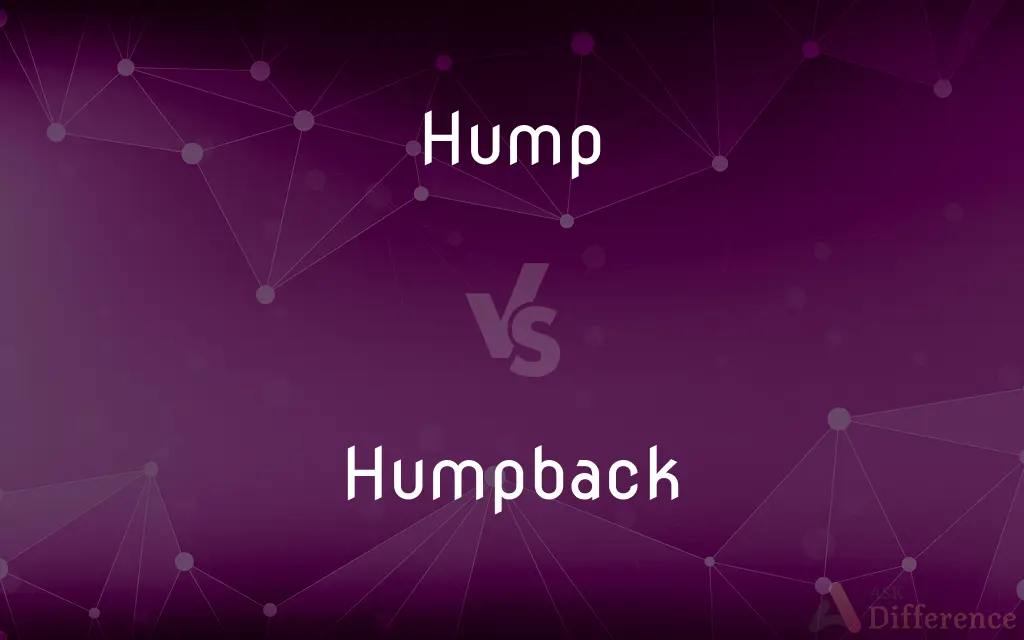Hump vs. Humpback — What's the Difference?
By Tayyaba Rehman & Maham Liaqat — Updated on April 23, 2024
Hump generally refers to a rounded protuberance found on the back of some animals, while humpback specifically identifies a species of whale or describes a person or animal with a curved spine.

Difference Between Hump and Humpback
Table of Contents
ADVERTISEMENT
Key Differences
A hump is a physical feature that manifests as a rounded protrusion on the backs of certain animals, notably camels, which is used for fat storage. Whereas humpback specifically describes a type of whale known for its distinctive body shape, including a protruding back and long pectoral fins. This feature in camels is crucial for their survival in desert environments, providing necessary nutrients during food scarcity.
In terms of human anatomy, the term hump can describe abnormal curvatures of the spine, such as those caused by kyphosis. On the other hand, humpback in this context strictly refers to severe cases of kyphosis, where the spine curvature is pronounced and noticeably affects posture.
The usage of the word hump is more versatile, extending metaphorically to describe any sort of bump or rise, such as a speed hump on a road. Whereas humpback remains a specialized term, predominantly used in biology to describe specific anatomical features or species, such as the humpback whale.
Humpback whales are named after their characteristic hump-like curvature of their back visible when diving. In contrast, the term hump does not correspond to any specific species but is a generic anatomical term applicable to various animals with this feature.
In folklore and storytelling, hump or humped figures often symbolize burden or deformity, enhancing a narrative's thematic elements. Conversely, the humpback whale has become a symbol of conservation success and marine majesty, representing the triumph over whaling and the importance of ecological preservation.
ADVERTISEMENT
Comparison Chart
Definition
A rounded protuberance on the back
A whale species or severe spinal curvature
Context
Found in animals, used metaphorically
Specifically refers to whales or pathology
Usage in Biology
Describes anatomy in various animals
Refers to a specific whale species
Symbolism
Often indicates burden in folklore
Represents conservation in marine biology
Associated Terms
Camel hump, speed hump
Humpback whale, humpback bridge
Compare with Definitions
Hump
A rounded protrusion on the back of an animal, especially camels.
The camel's hump is vital for its survival in the desert.
Humpback
A whale species known for its distinctive body shape.
The humpback whale is famous for its majestic breaches.
Hump
A slang term for carrying or moving with effort.
He humped his backpack all the way up the hill.
Humpback
Refers to someone with a hunched back.
The character in the novel was a humpback, walking with a noticeable bend.
Hump
A bump or rise in a surface.
The road has a hump near the intersection to slow down traffic.
Humpback
Used to describe something that is arched or bent.
The old bridge is often called a humpback because of its curved arch.
Hump
A metaphorical term for a difficulty or challenge.
Once you get over the initial hump, the project becomes much easier.
Humpback
A descriptive term for a severely curved spine.
She was diagnosed with a humpback due to her advanced kyphosis.
Hump
A rounded mass or protuberance, such as the fleshy structure on the back of a camel or of some cattle.
Humpback
A term used in design to describe a curved feature.
The new model of the car has a humpback design to increase aerodynamics.
Hump
A deformity of the back in humans caused by an abnormal convex curvature of the upper spine.
Humpback
See hunchback.
Hump
A low mound of earth; a hummock.
Humpback
A humped upper back.
Hump
A mountain range.
Humpback
A humpback whale.
Hump
Chiefly British A fit of depression; an emotional slump.
Humpback
A humped back deformity in humans caused by abnormal curvature of the upper spine.
Hump
To bend or round into a hump; arch.
Humpback
(by extension) A hump or protuberance on the shoulders or back of an animal.
Hump
To exert (oneself).
Humpback
(figurative) A rounded topographical feature, such as a mountain or hill.
Hump
To carry, especially on the back.
Humpback
A person with a humpback; a person who suffers from kyphosis.
Hump
(Slang) To exert oneself.
Humpback
A humpback whale.
Hump
(Slang) To hurry.
Humpback
A humpback salmon.
Hump
A mound of earth.
Humpback
To hunt humpback whales.
Hump
A speed bump or speed hump.
Humpback
A crooked back; a humped back.
Hump
A deformity in humans caused by abnormal curvature of the upper spine.
Humpback
A humpbacked person; a hunchback.
Hump
A rounded fleshy mass, such as on a camel or zebu.
Humpback
Any whale of the genus Megaptera, characterized by a hump or bunch on the back. Several species are known. The most common ones in the North Atlantic are Megaptera longimana of Europe, and Megaptera osphyia of America; that of the California coasts is Megaptera versabilis.
Hump
A bad mood.
She's got the hump with me.
Go away! You're giving me the right hump.
Humpback
An abnormal backward curve to the vertebral column
Hump
(slang) A painfully boorish person.
That guy is such a hump!
Humpback
A person whose back is hunched because of abnormal curvature of the upper spine
Hump
A wave that forms in front of an operating hovercraft and impedes progress at low speeds.
Humpback
Large whalebone whale with long flippers noted for arching or humping its back as it dives
Hump
(transitive) To bend something into a hump.
Hump
To carry (something), especially with some exertion.
Hump
To dry-hump.
Stop humping the table, you sicko.
Hump
To prepare for a great exertion; to put forth effort.
Hump
To vex or annoy.
Hump
(rail) To shunt wagons / freight cars over the hump in a hump yard.
Hump
A protuberance; especially, the protuberance formed by a crooked back.
Hump
A fleshy protuberance on the back of an animal, as a camel or whale.
Hump
A portion of a switchyard with a slanting track in which freight cars may coast without an engine and be sorted through a series of switches.
Hump
To form into a hump; to make hump-shaped; to hunch; - often with up.
The cattle were very uncomfortable, standing humped up in the bushes.
Hump
To put or carry on the (humped) back; to shoulder; hence, to carry, in general.
Having collected a sufficient quantity, we humped it out of the bush.
Hump
To bend or gather together for strenuous effort, as in running; to do or effect by such effort; to exert; - usually reflexively or with it; as, you must hump yourself.
A half dozen other negroes, some limping and all scared, were humping it across a meadow.
Hump
To sort freight cars by means of a hump.
Hump
Something that bulges out or is protuberant or projects from a form
Hump
Arch one's back
Common Curiosities
What are the primary reasons for a humpback condition in humans?
Humpback, or severe kyphosis, can be caused by degenerative diseases, osteoporosis, spinal injuries, or developmental problems.
How does the hump benefit a camel?
The hump stores fat, which camels can convert to water and energy when food and water are scarce, aiding their survival in harsh desert climates.
Are there other animals besides camels and whales known for having a hump?
Yes, some breeds of cattle and bison also have humps, which serve similar fat storage purposes as those of camels.
Is the hump in humpback whales similar to the hump in camels?
No, the hump in humpback whales is more of a body shape for efficient swimming and diving, unlike the fat-storage function of camel humps.
What is the difference in spinal curvature between a normal spine and a humpback spine?
A normal spine has a natural curve, but with humpback, the curve is exaggerated and creates a noticeable arch or hunch in the back.
Can a hump on a road or bridge have practical purposes?
Yes, humps on roads, often called speed bumps or humps, are designed to slow traffic, enhancing safety near pedestrian areas.
What role does the humpback whale play in marine ecosystems?
Humpback whales contribute to marine ecosystems by affecting prey populations and facilitating nutrient mixing through their feeding behavior.
Is "hump" only associated with camels?
No, while camels are the most common association, "hump" can refer to any rounded protuberance on the back of an animal or metaphorically to describe bumps in surfaces.
How do humps affect the movement or behavior of animals that have them?
For camels, the hump provides energy which allows them to travel long distances without food. In whales, the body shape helps in deep diving and long-distance swimming.
Can humpback condition in humans be treated or corrected?
Yes, treatments for humpback or kyphosis can include physical therapy, braces, and in severe cases, surgery to correct spinal alignment.
Is "hump" used in any specific idioms or expressions?
Yes, the phrase "over the hump" is a common idiom meaning to move past the hardest part of a task or project.
How can humpback whales be identified among other whales?
Humpback whales are identified by their long pectoral fins, distinctive body shape, and unique patterns on their tails.
Are there any cultural or symbolic significances associated with humpback whales?
Humpback whales are often symbols of conservation efforts due to their recovery from near extinction, representing hope and ecological balance.
What historical significance do humpback whales hold in whaling history?
Humpback whales were heavily targeted by whaling industries until international protection efforts significantly reduced whaling activities.
What kind of metaphorical uses does "hump" have in language?
In metaphorical usage, "hump" can refer to overcoming a challenge or difficulty, often described as getting over a hump.
Share Your Discovery

Previous Comparison
Agitation vs. Mixing
Next Comparison
Ox vs. FoxAuthor Spotlight
Written by
Tayyaba RehmanTayyaba Rehman is a distinguished writer, currently serving as a primary contributor to askdifference.com. As a researcher in semantics and etymology, Tayyaba's passion for the complexity of languages and their distinctions has found a perfect home on the platform. Tayyaba delves into the intricacies of language, distinguishing between commonly confused words and phrases, thereby providing clarity for readers worldwide.
Co-written by
Maham Liaqat













































